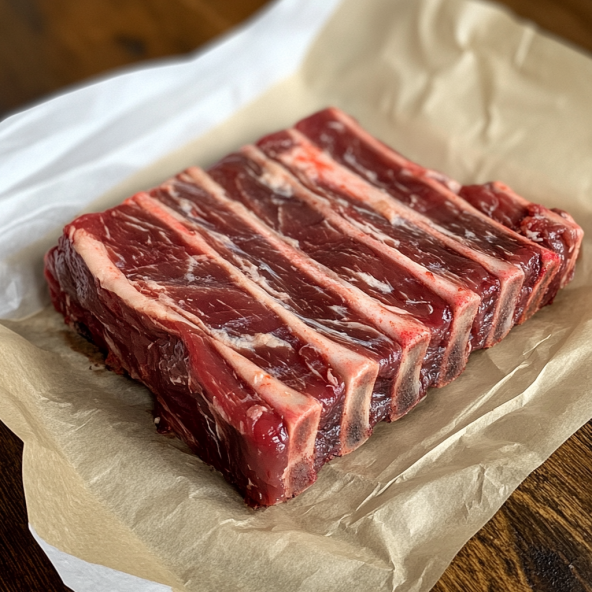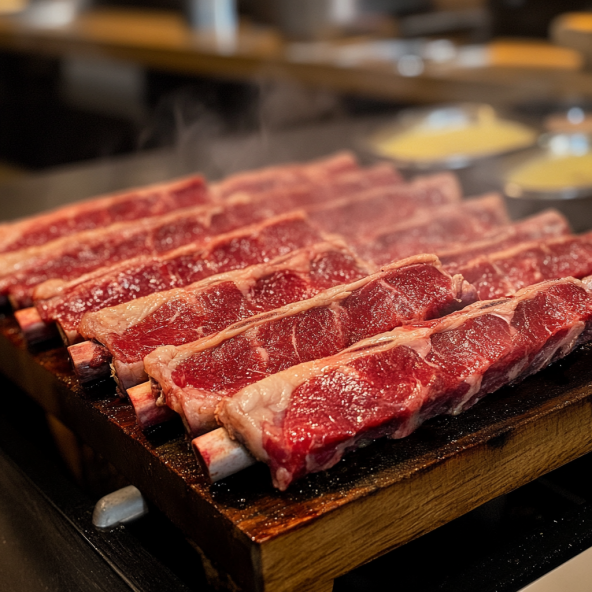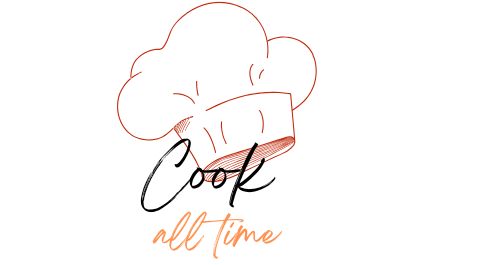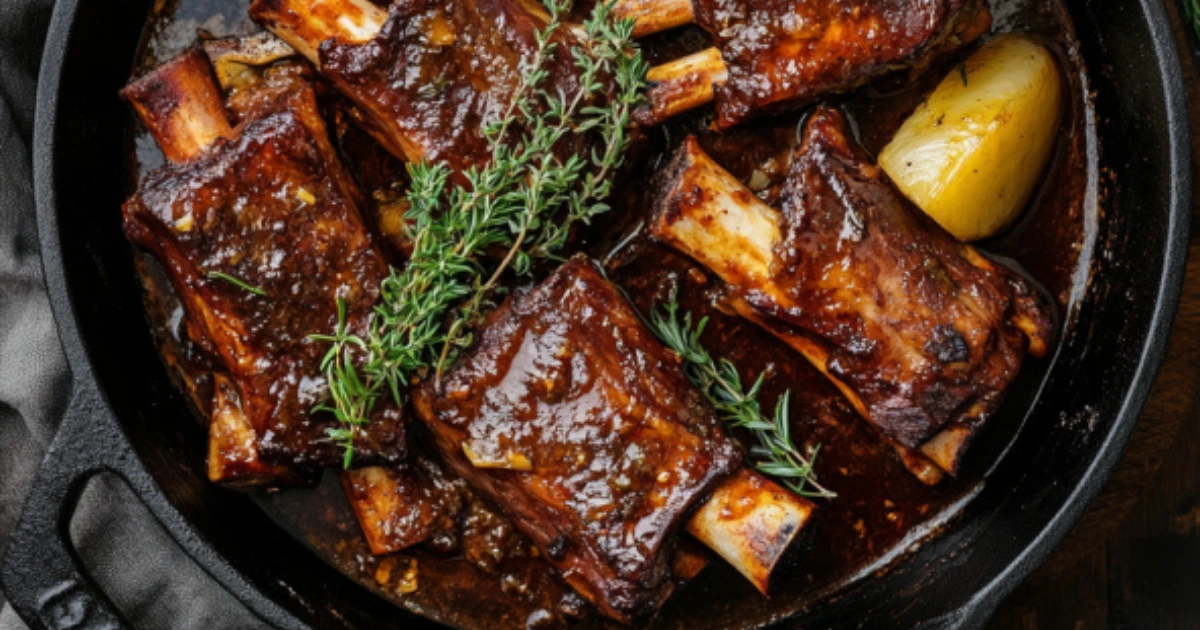How Are Beef Ribs Supposed to Be Cooked?
Beef ribs, with their rich flavor and tender texture, are a favorite for many meat lovers. But knowing how are beef ribs supposed to be cooked is key to ensuring that every rib you cook turns out perfectly. Cooking beef ribs can be a rewarding experience, but the process involves various methods and techniques to enhance the flavor and texture. From trimming to seasoning, to choosing the right cooking method, each step plays a crucial role. In this guide, we’ll explore everything you need to know about beef ribs, ensuring that you achieve mouthwatering results every time.
Table of Contents
Understanding How Beef Ribs Are Supposed to Be Cooked
Types of Beef Ribs and How They Are Cooked
When it comes to how beef ribs are supposed to be cooked, it’s essential to understand the different types of beef ribs available. The most common types are:
- Beef back ribs: These ribs come from the top of the cow’s rib cage and have less meat than other cuts. However, the meat they do have is tender and flavorful.
- Beef short ribs: Short ribs are cut from the rib section but are much meatier. They’re perfect for braising or slow-cooking due to their fat content.
- Beef spare ribs: These are often larger and meatier, similar to short ribs but with a different cut. They’re typically great for grilling or smoking.
Each of these cuts requires a slightly different approach when cooking, and knowing which type you have can help you decide the best cooking method.
beef ribs supposed to be cooked lies in understanding these differences and adjusting your cooking methods accordingly.
The Anatomy of Beef Ribs
What Makes Beef Ribs Flavorful?
Beef ribs are known for their robust, savory flavor, which comes from the rich marbling of fat that runs through the meat. The fat helps keep the meat moist during cooking, contributing to a tender and juicy texture. Additionally, beef ribs absorb smoke and seasoning exceptionally well, which enhances their flavor profile.
The meat on beef ribs is also denser compared to cow ribs, which means it can stand up to stronger spices, rubs, and marinades. This makes them ideal for longer cooking methods such as smoking or braising.
How to Identify High-Quality Beef Ribs
When purchasing beef ribs, quality is essential to achieving the best flavor and texture. Look for the following characteristics:
- Well-marbled meat: The fat distribution should be even, ensuring that the meat remains tender throughout the cooking process.
- Freshness: Fresh beef ribs should have a deep red color and a firm texture. Avoid ribs with dark spots or an unpleasant odor.
- Thickness of the meat: Ideally, the meat should cover the bones generously without being excessively fatty.
Choosing high-quality beef ribs ensures that your cooking efforts result in a flavorful, satisfying meal.
Preparing beef ribs
How to Trim and Clean Beef Ribs
Before cooking, it’s essential to trim and clean your beef ribs to enhance their flavor and texture. Here’s how:
- Remove the membrane: The membrane on the back of beef ribs can be tough and chewy when cooked. Use a knife to carefully peel it off.
- Trim excess fat: While some fat is necessary for moisture, too much fat can cause the ribs to be greasy. Trim the outer layer to expose the meat without removing all the fat.
- Square the edges: If the ribs are unevenly cut, square off the edges to ensure they cook evenly.
Proper preparation can significantly impact the final result, so take your time with these steps to ensure the best outcome.
Choosing the Best Seasoning Rubs and Marinades
Seasoning is crucial when preparing beef ribs. While simple salt and pepper work well, you can enhance the flavor by using a variety of marinades and dry rubs. Consider these options:
- Dry rubs: A mix of brown sugar, paprika, garlic powder, salt, and pepper can add a flavorful crust to your ribs.
- Marinades: For extra flavor, use a marinade with vinegar, soy sauce, Worcestershire sauce, and spices. Marinate for several hours or overnight for the best results.
Marinating beef ribs or applying a dry rub will help tenderize the meat and infuse it with bold flavors, making it ideal for the slow cooking methods that beef ribs require.
Best Cooking Techniques for Beef Ribs: How Are Beef Ribs Supposed to Be Cooked?
Grilling Beef Ribs: A Great Way to Cook Beef Ribs
Grilling is a popular method for cooking beef ribs, especially for beef back ribs, as it imparts a delicious charred flavor. However, how are beef ribs supposed to be cooked on the grill? Low and slow is key. Here’s how:

- Preheat your grill to a medium-low temperature.
- Place the ribs on the grill and cook with the lid closed, ensuring indirect heat.
- Turn the ribs occasionally, cooking for 2-3 hours depending on the size of the cut.
Using this technique, you’ll achieve crispy, flavorful ribs with a smoky finish.
Smoking Beef Ribs for Extra Flavor
Smoking beef ribs is one of the best ways to infuse them with a deep, savory flavor. This method involves cooking the ribs at a low temperature for several hours, allowing the meat to become tender and juicy.
- Maintain a consistent temperature of 225°F-250°F.
- Use wood chips such as hickory or oak for a smoky aroma.
- Smoke the ribs for 4-6 hours, depending on the size and cut.
Smoking is an excellent choice for beef short ribs and beef spare ribs, as the slow cooking process allows the fat to render, making the ribs tender and flavorful.
Braising Beef Ribs for Tender Results
Braising is ideal for tougher cuts, like beef short ribs, because it uses moist heat to break down the meat.
- Brown the ribs in a pan before placing them in a pot with broth .
- Cover and cook on low heat for 3-4 hours until the meat is tender.
- Braising enhances the flavor by infusing the ribs with the cooking liquid.
This method is perfect for a hearty, comforting meal.
Oven-Roasting Beef Ribs: How to Cook Beef Ribs in the Oven
Oven-roasting is another great option for beef ribs. It allows for consistent heat and results in tender, juicy meat.
- Preheat your oven to 275°F.
- Place the ribs on a baking sheet lined with foil.
- Roast for 2-3 hours, checking occasionally for tenderness.
Oven-roasting works well for all types of beef ribs, especially if you’re looking for a hands-off method.
Common Mistakes to Avoid When Cooking beef ribs supposed
Overcooking or Undercooking Beef Ribs
One of the most common mistakes when cooking beef ribs is not monitoring the cooking time and temperature. How are beef ribs supposed to be cooked correctly? The answer lies in cooking low and slow. Overcooking can lead to dry, tough ribs, while undercooking may result in chewy, hard meat. Use a meat thermometer to check for doneness, aiming for an internal temperature of 190°F-203°F for maximum tenderness.
Improper Seasoning for beef ribs supposed
Failing to season the ribs properly is another mistake. Be generous with your rub or marinade, ensuring that every surface of the ribs is coated. This enhances the flavor and creates a delicious crust.
Rushing the Beef Rib Cooking Process
Rushing through the cooking process is a surefire way to end up with subpar ribs. Beef ribs require time to cook properly. Allow them to rest after cooking, which helps redistribute the juices and makes the meat even more flavorful.
Tools You’ll Need for Perfect Beef Ribs: How to Cook Beef Ribs Right
Essential Equipment for Cooking Beef Ribs
To cook beef ribs properly, you need the right tools:
- Grill: For grilling beef ribs, a charcoal or gas grill works well.
- Smoker: A smoker is ideal for infusing the ribs with smoky flavor.
- Oven: If you prefer oven-roasting, a standard oven works just fine.
Having the right cooking equipment is essential for achieving the perfect beef ribs.
Useful Accessories to Enhance the Cooking Process
Investing in a few key accessories can make a big difference:
- Meat thermometer: Ensures the ribs reach the proper internal temperature.
- Basting brush: Helps apply marinades or sauces evenly during cooking.
With these tools, you’ll be able to cook beef ribs like a pro.
Step-by-Step Guide to Cooking Beef Ribs
Preparing the Ribs
When it comes to how are beef ribs supposed to be cooked, the first step is preparation. This involves several key tasks:
- Trim the fat: Excess fat can cause your ribs to become greasy. Trim away the fat around the edges but leave a thin layer for moisture and flavor.
- Remove the membrane: On the back of the ribs, you’ll find a tough membrane that can hinder flavor absorption. Use a knife to carefully remove it.
- Seasoning: Apply a generous amount of dry rub or marinade to the ribs. This ensures that the ribs will absorb flavor during cooking. Let them marinate for a few hours or overnight for best results.
Once prepped, the ribs are ready to be cooked using your chosen method.
Cooking Process for Each Method
Now, let’s dive into the how are beef ribs supposed to be cooked for different techniques:
- Grilling: Preheat your grill to medium-low heat. Place the ribs on the grill and cook for 2-3 hours with the lid closed, flipping occasionally. This will result in crispy, flavorful beef ribs with a smoky touch.
- Smoking: Smoking beef ribs takes longer but enhances their flavor. Maintain a temperature of 225°F-250°F for 4-6 hours. Add wood chips like hickory or oak for additional smoky flavor.
- Braising: For tougher cuts like short ribs, braising is ideal. Brown the ribs in a pot, then simmer them in a liquid for 3-4 hours.
- Oven-roasting: Preheat the oven to 275°F. Roast the ribs on a baking sheet for 2-3 hours until tender and juicy.
Each of these methods will give you perfectly cooked beef ribs, but the choice depends on the flavor and texture you desire.
Pairing Beef Ribs with Sides
Best Side Dishes for Beef Ribs
When asking how are beef ribs supposed to be cooked, it’s important to consider the sides that complement them. The rich, savory flavor of beef ribs pairs well with:

- Grilled vegetables: Corn on the cob, asparagus, and bell peppers balance the richness of the ribs.
- Coleslaw: The tangy crunch of coleslaw cuts through the fattiness of beef ribs and adds a refreshing contrast.
- Mashed potatoes: Creamy mashed potatoes absorb the juices from the beef ribs, making for a comforting side.
- Baked beans: The slight sweetness of baked beans complements the smoky flavor of the beef ribs.
These sides work harmoniously with beef ribs, enhancing their flavor and creating a well-rounded meal.
Ideal Beverages to Complement the Flavors
To complete your beef ribs meal, pair it with the right beverage. Consider these options:
- Iced tea: For a non-alcoholic option, iced tea with lemon is a refreshing and slightly tart contrast to the fatty meat.
By choosing the right beverage, you’ll elevate the overall dining experience and create a balanced meal.
How to Store and Reheat beef ribs supposed
Best Practices for Leftovers
Knowing how are beef ribs supposed to be cooked includes understanding how to store leftovers properly. After enjoying your meal, follow these steps to store your beef ribs:
- Cool down: Allow the ribs to cool to room temperature before storing them.
- Wrap properly: Use aluminum foil or plastic wrap to securely wrap the ribs. Alternatively, you can store them in an airtight container.
- Refrigeration: Store the wrapped ribs in the refrigerator for up to 3-4 days. This will help preserve their flavor and moisture.
Proper storage ensures that your beef ribs remain delicious and ready for reheating when you’re ready to enjoy them again.
Reheating Techniques
To reheat beef ribs without sacrificing tenderness or flavor:
- Oven: Preheat your oven to 250°F. Wrap the ribs in foil and heat for about 15-20 minutes, or until warmed through.
- Grill: Reheat the ribs on the grill over indirect heat for 10-15 minutes, turning occasionally to avoid overcooking.
- Microwave: For a quicker option, microwave the ribs for 2-3 minutes, covering them with a damp paper towel to retain moisture.
Using these techniques will help keep your beef ribs juicy and flavorful even after storing them.
Nutritional Value of Beef Ribs
Protein Content
Beef ribs are an excellent source of high-quality protein, which is essential for muscle growth, repair, and overall body function. On average, a 3-ounce serving of beef ribs contains around 20 grams of protein. This makes them a great option for those looking to meet their daily protein needs while enjoying a flavorful meal.
Other Nutrients and Health Benefits
Besides protein, beef ribs also provide a range of other essential nutrients, including:
- Iron: Important for red blood cell production and preventing anemia.
- Zinc: Supports immune function and wound healing.
- Vitamins B6 and B12: Essential for energy metabolism and brain health.
While beef ribs are rich in nutrients, they should be consumed in moderation due to their higher fat content. However, they can be part of a balanced diet when enjoyed as a treat.
FAQs About How are beef ribs supposed to be cooked
What Temperature Should Beef Ribs Be Cooked To?
Beef ribs should be cooked to an internal temperature of 190°F-203°F to ensure they are tender and fully cooked. Use a meat thermometer to ensure accuracy.
How Long Does It Take to Cook Beef Ribs?
The cooking time varies depending on the method:
- Grilling: 2-3 hours on indirect heat.
- Smoking: 4-6 hours at low temperatures.
- Braising: 3-4 hours for short ribs.
- Oven-roasting: 2-3 hours at 275°F.
What Are the Differences Between Short Ribs and Back Ribs?
- Short ribs: These are meatier and come from the rib section near the belly. They are ideal for braising or slow cooking.
- Back ribs: These come from the upper rib cage and have less meat but are great for grilling or smoking.For more ideas, visit What Are Beef Back Ribs Good For?.
Can Beef Ribs Be Cooked in an Air Fryer?
Yes, beef ribs can be cooked in an air fryer. Preheat the air fryer, season the ribs, and cook at 375°F for about 25-30 minutes, turning halfway through.
What’s the Best Wood for Smoking Beef Ribs?
Hickory, oak, and mesquite are some of the best woods for smoking beef ribs. These woods add a deep, smoky flavor that complements the rich taste of beef.
How Do You Prevent Beef Ribs from Drying Out?
To prevent beef ribs from drying out, cook them low and slow, ensuring that the meat stays moist. Wrapping the ribs in foil during cooking helps retain moisture. Additionally, basting the ribs periodically will keep them juicy.
Tips for First-Time Cooks
For those asking how are beef ribs supposed to be cooked for the first time, here are a few helpful tips:
- Be patient: Rushing the cooking process can lead to tough ribs. Allow plenty of time for slow cooking.
- Use a thermometer: A meat thermometer ensures your ribs reach the correct internal temperature without overcooking.
- Experiment with flavors: Don’t hesitate to try different rubs, marinades, and wood chips to find your preferred flavor profile.
With these tips, even first-time cooks can enjoy tender, flavorful beef ribs.
Conclusion :How are beef ribs supposed to be cooked
In conclusion, how are beef ribs supposed to be cooked is a question that depends on your preferred cooking method. Whether grilling, smoking, braising, or oven-roasting, each technique brings out different flavors and textures in the beef. By following the preparation steps, cooking tips, and pairing suggestions in this guide, you can ensure that your beef ribs turn out delicious and tender every time. With practice and patience, cooking beef ribs can become a rewarding culinary experience.

